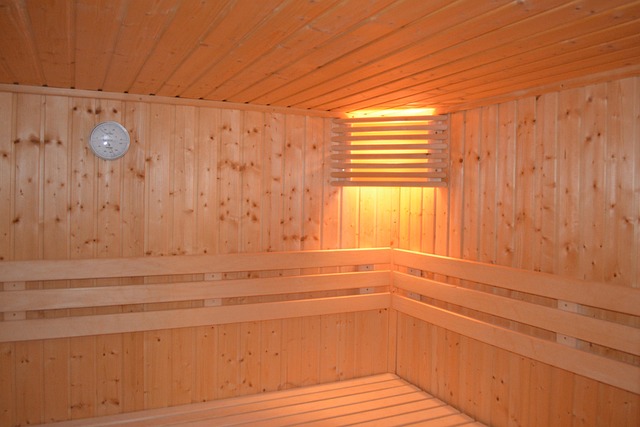Infrared body wraps, a modern wellness trend, use low-level infrared radiation to directly heat the body, promoting relaxation, reducing muscle tension, improving flexibility, and enhancing overall well-being through endorphin release and improved circulation. Compared to traditional saunas that induce sweating via dry heat, infrared wraps offer a gentler alternative with potential benefits like enhanced flexibility and collagen production while still aiding detoxification. Choose between infrared wraps or saunas based on your preferences and health goals: wraps for convenient relaxation and metabolic boost, or saunas for detoxification and cardiovascular health.
Infrared body wraps and saunas have long been sought for their purported health benefits, but which offers superior results? This article delves into these two distinct approaches to heat therapy. We’ll explore how infrared body wraps work, uncovering their unique advantages in fat reduction and muscle relaxation. Conversely, we’ll examine the traditional sauna experience and its role in detoxification. By comparing their features and effects, you’ll be equipped to make an informed choice for your wellness journey, focusing on the power of infrared body wraps.
Understanding Infrared Body Wraps: How They Work and Their Benefits
Infrared body wraps are a modern wellness trend gaining traction for their purported health benefits. Unlike traditional saunas that rely on heated air, infrared body wraps use low-level infrared radiation to warm the body directly. This technology penetrates the skin and heats tissues at a cellular level, boosting circulation and promoting relaxation. The gentle heat helps reduce muscle tension, improve flexibility, and enhance overall well-being.
One of the key advantages of infrared body wraps is their ability to induce a deep state of relaxation. By elevating core body temperature, they mimic the effects of mild exercise, stimulating the release of endorphins—the body’s natural painkillers and mood elevators. Additionally, improved circulation can aid in detoxification by enhancing lymphatic flow, which carries toxins out of cells and transports them to be eliminated from the body.
The Sauna Experience: Traditional Sweating for Detoxification
The sauna experience offers a traditional method of detoxification through sweating. It involves sitting or lying down in a heated room, typically made of wood, where dry heat is generated to elevate body temperature and induce perspiration. This process has been practiced for centuries as a natural way to cleanse the body. The heat causes blood vessels to dilate, increasing circulation and promoting the elimination of toxins through sweat.
Infrared body wraps complement this natural detoxification process by utilizing specific wavelengths of light to penetrate the skin, warming the body from within. This modern approach enhances the effects of traditional sauna sessions, allowing for deeper relaxation and potential additional health benefits.
Comparing the Two: Features and Effects on the Body
Infrared body wraps and saunas are both popular methods for relaxation and detoxification, but they operate on different principles. Infrared body wraps use heated pads or blankets emitting infrared radiation to directly heat the body’s tissues. This can lead to increased circulation, deeper muscle relaxation, and faster recovery from exercise. The infrared heat also promotes sweating, helping to eliminate toxins and impurities from the skin.
On the other hand, saunas rely on dry heat generated by a sauna stove or electric heating elements. This heats the air in the sauna chamber, causing individuals to sweat profusely. Saunas are known for their ability to relax the mind and body, improve cardiovascular health, and support detoxification through sweating. While saunas can be more intense, infrared body wraps offer a non-thermal alternative with potential benefits such as enhanced flexibility and improved collagen production due to gentle heat application.
Making an Informed Choice: Considerations for Selection
Making a choice between infrared body wraps and saunas depends on understanding their unique benefits and how they work. Infrared body wraps use heat from infrared lamps to penetrate the skin, increasing blood circulation and promoting relaxation. This method is often preferred for its convenience; you can sit or lie down while wrapped in a heated blanket, allowing for hands-free relaxation. It’s also effective for muscle soreness relief and weight loss, as it raises your metabolic rate.
Saunas, on the other hand, heat up an enclosed space, creating a steamy environment that helps eliminate toxins through sweating. This traditional approach has been shown to improve cardiovascular health and reduce stress levels. The decision comes down to personal preference and specific health goals. If convenience and targeting muscle issues are priorities, infrared body wraps might be the better choice. However, if you seek a deeper sweat session for detoxification and enhanced cardiovascular fitness, opting for a sauna could be more suitable.
Infrared body wraps and saunas both offer unique ways to promote relaxation and detoxification. While saunas have been a traditional method for centuries, infrared body wraps provide a modern twist with targeted heat application. In terms of effectiveness, both have their merits. Saunas induce sweating, aiding in the elimination of toxins, while infrared wraps penetrate deeper into the muscles, promoting blood circulation and reducing inflammation. Ultimately, the choice depends on personal preference and desired outcomes. For a luxurious and scientifically advanced experience, infrared body wraps may be the game-changer you’re looking for; but if tradition and a classic detox method appeal more, saunas stand the test of time.
